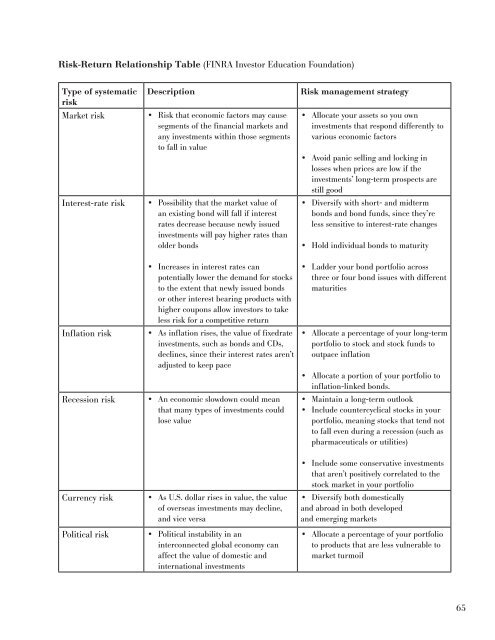Tips and Tools For Financial Success - Newton Free Library
Tips and Tools For Financial Success - Newton Free Library
Tips and Tools For Financial Success - Newton Free Library
Create successful ePaper yourself
Turn your PDF publications into a flip-book with our unique Google optimized e-Paper software.
Risk-Return Relationship Table (FINRA Investor Education Foundation)<br />
Type of systematic<br />
risk<br />
Market risk<br />
Interest-rate risk<br />
Inflation risk<br />
Recession risk<br />
Description<br />
• Risk that economic factors may cause<br />
segments of the financial markets <strong>and</strong><br />
any investments within those segments<br />
to fall in value<br />
• Possibility that the market value of<br />
an existing bond will fall if interest<br />
rates decrease because newly issued<br />
investments will pay higher rates than<br />
older bonds<br />
• Increases in interest rates can<br />
potentially lower the dem<strong>and</strong> for stocks<br />
to the extent that newly issued bonds<br />
or other interest bearing products with<br />
higher coupons allow investors to take<br />
less risk for a competitive return<br />
• As inflation rises, the value of fixedrate<br />
investments, such as bonds <strong>and</strong> CDs,<br />
declines, since their interest rates aren’t<br />
adjusted to keep pace<br />
• An economic slowdown could mean<br />
that many types of investments could<br />
lose value<br />
Risk management strategy<br />
• Allocate your assets so you own<br />
investments that respond differently to<br />
various economic factors<br />
• Avoid panic selling <strong>and</strong> locking in<br />
losses when prices are low if the<br />
investments’ long-term prospects are<br />
still good<br />
• Diversify with short- <strong>and</strong> midterm<br />
bonds <strong>and</strong> bond funds, since they’re<br />
less sensitive to interest-rate changes<br />
• Hold individual bonds to maturity<br />
• Ladder your bond portfolio across<br />
three or four bond issues with different<br />
maturities<br />
• Allocate a percentage of your long-term<br />
portfolio to stock <strong>and</strong> stock funds to<br />
outpace inflation<br />
• Allocate a portion of your portfolio to<br />
inflation-linked bonds.<br />
• Maintain a long-term outlook<br />
• Include countercyclical stocks in your<br />
portfolio, meaning stocks that tend not<br />
to fall even during a recession (such as<br />
pharmaceuticals or utilities)<br />
Currency risk<br />
Political risk<br />
• As U.S. dollar rises in value, the value<br />
of overseas investments may decline,<br />
<strong>and</strong> vice versa<br />
• Political instability in an<br />
interconnected global economy can<br />
affect the value of domestic <strong>and</strong><br />
international investments<br />
• Include some conservative investments<br />
that aren’t positively correlated to the<br />
stock market in your portfolio<br />
• Diversify both domestically<br />
<strong>and</strong> abroad in both developed<br />
<strong>and</strong> emerging markets<br />
• Allocate a percentage of your portfolio<br />
to products that are less vulnerable to<br />
market turmoil<br />
65




